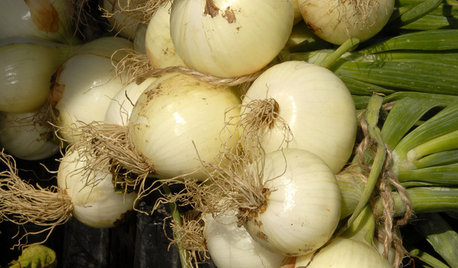Wild Onions are Coming Up. Best Product/When to Use?
ntl1991
13 years ago
Related Stories

HOUZZ TVHouzz TV: First Comes Love, Then Comes a Wildly Colorful Mosaic Home
This couple spent two decades covering their home inside and out with brightly colored mosaic tile, vibrant paint, small toys and more
Full Story
FARM YOUR YARD9 Ways to Change Up Your Vegetable Garden for the Coming Season
Try something new for edible plantings that are more productive than ever
Full Story
COOL-SEASON CROPSCool-Season Vegetables: How to Grow Onions
Essential for a cook's garden, onions come in many varieties and show staying power on the shelf
Full Story
GARDENING GUIDESGreat Design Plant: Wild Lupine Dresses Up Rocky Gardens
Spiky blue flowers and a high tolerance for poor soil make this plant ideal for tough sites
Full Story
FUN HOUZZScreen Style Forecast: When the 'Girls' Grow Up
We predict which decorating styles the girls on HBO's new series will choose when their taste matures. Do any match yours?
Full Story
KITCHEN DESIGN9 Questions to Ask When Planning a Kitchen Pantry
Avoid blunders and get the storage space and layout you need by asking these questions before you begin
Full Story
COLORCooking With Color: When to Use Gray in the Kitchen
Try out Trout or shake up some Martini Shaker gray for a neutral-based kitchen that whispers of sophistication
Full Story
HEALTHY HOME12 Ways to Set Up Your Kitchen for Healthy Eating
Making smart food choices is easier when your kitchen is part of your support team
Full Story
CONTRACTOR TIPSBuilding Permits: When a Permit Is Required and When It's Not
In this article, the first in a series exploring permit processes and requirements, learn why and when you might need one
Full Story
PRODUCT PICKSGuest Picks: Company is Coming!
20 ways to spruce up your home in time for visiting guests
Full StoryMore Discussions








nearandwest
Gags
Related Professionals
Wrentham Landscape Architects & Landscape Designers · New Bedford Landscape Architects & Landscape Designers · Glen Ellyn Landscape Architects & Landscape Designers · Fairview Landscape Contractors · Fridley Landscape Contractors · Lake Worth Landscape Contractors · Lemont Landscape Contractors · Lynwood Landscape Contractors · Mission Bend Landscape Contractors · Munster Landscape Contractors · Old Saybrook Landscape Contractors · Wailuku Landscape Contractors · Selma Landscape Contractors · Redlands Swimming Pool Builders · South Miami Heights Swimming Pool Buildersntl1991Original Author
ntl1991Original Author
dchall_san_antonio
BryanAlff
ntl1991Original Author
dchall_san_antonio
ntl1991Original Author
thurston9
Plant-ME53